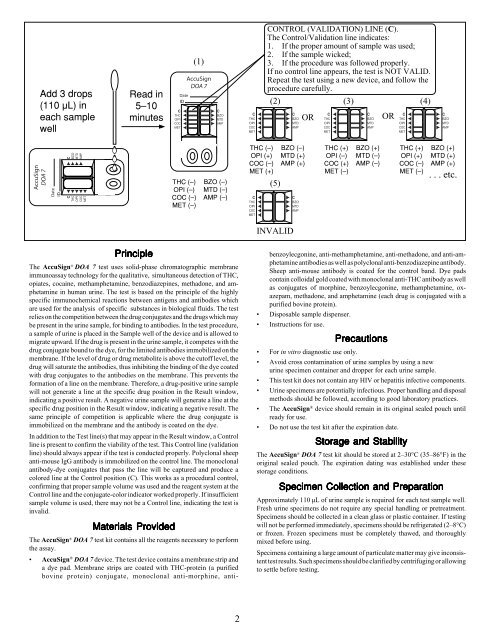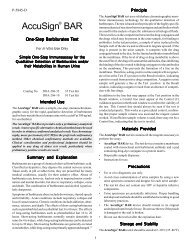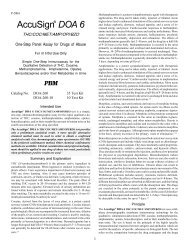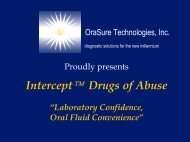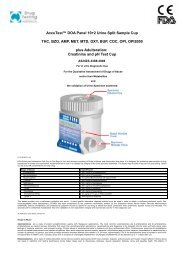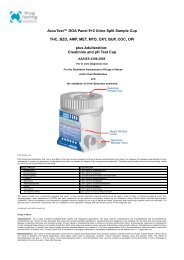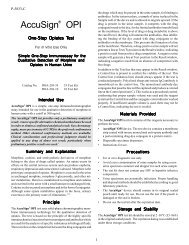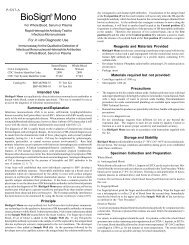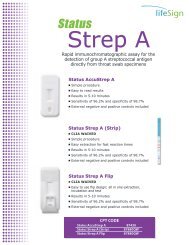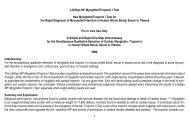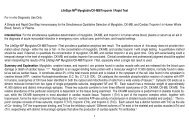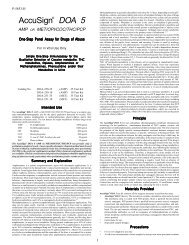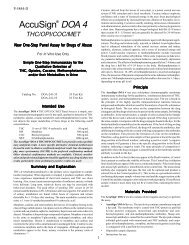AccuSign DOA 7.pdf - Drug Testing
AccuSign DOA 7.pdf - Drug Testing
AccuSign DOA 7.pdf - Drug Testing
You also want an ePaper? Increase the reach of your titles
YUMPU automatically turns print PDFs into web optimized ePapers that Google loves.
Add 3 drops<br />
(110 µL) in<br />
each sample<br />
well<br />
Read in<br />
5–10<br />
minutes<br />
(1)<br />
CONTROL (VALIDATION) LINE (C).<br />
The Control/Validation line indicates:<br />
1. If the proper amount of sample was used;<br />
2. If the sample wicked;<br />
3. If the procedure was followed properly.<br />
If no control line appears, the test is NOT VALID.<br />
Repeat the test using a new device, and follow the<br />
procedure carefully.<br />
(2) (3) (4)<br />
OR<br />
OR<br />
THC (–)<br />
OPI (–)<br />
COC (–)<br />
MET (–)<br />
BZO (–)<br />
MTD (–)<br />
AMP (–)<br />
THC (–)<br />
OPI (+)<br />
COC (–)<br />
MET (+)<br />
(5)<br />
BZO (–)<br />
MTD (+)<br />
AMP (+)<br />
THC (+)<br />
OPI (–)<br />
COC (+)<br />
MET (–)<br />
BZO (+)<br />
MTD (–)<br />
AMP (–)<br />
THC (+)<br />
OPI (+)<br />
COC (–)<br />
MET (–)<br />
BZO (+)<br />
MTD (+)<br />
AMP (+)<br />
. . . etc.<br />
INVALID<br />
Principle<br />
The <strong>AccuSign</strong> ® <strong>DOA</strong> 7 test uses solid-phase chromatographic membrane<br />
immunoassay technology for the qualitative, simultaneous detection of THC,<br />
opiates, cocaine, methamphetamine, benzodiazepines, methadone, and amphetamine<br />
in human urine. The test is based on the principle of the highly<br />
specific immunochemical reactions between antigens and antibodies which<br />
are used for the analysis of specific substances in biological fluids. The test<br />
relies on the competition between the drug conjugates and the drugs which may<br />
be present in the urine sample, for binding to antibodies. In the test procedure,<br />
a sample of urine is placed in the Sample well of the device and is allowed to<br />
migrate upward. If the drug is present in the urine sample, it competes with the<br />
drug conjugate bound to the dye, for the limited antibodies immobilized on the<br />
membrane. If the level of drug or drug metabolite is above the cutoff level, the<br />
drug will saturate the antibodies, thus inhibiting the binding of the dye coated<br />
with drug conjugates to the antibodies on the membrane. This prevents the<br />
formation of a line on the membrane. Therefore, a drug-positive urine sample<br />
will not generate a line at the specific drug position in the Result window,<br />
indicating a positive result. A negative urine sample will generate a line at the<br />
specific drug position in the Result window, indicating a negative result. The<br />
same principle of competition is applicable where the drug conjugate is<br />
immobilized on the membrane and the antibody is coated on the dye.<br />
In addition to the Test line(s) that may appear in the Result window, a Control<br />
line is present to confirm the viability of the test. This Control line (validation<br />
line) should always appear if the test is conducted properly. Polyclonal sheep<br />
anti-mouse IgG antibody is immobilized on the control line. The monoclonal<br />
antibody-dye conjugates that pass the line will be captured and produce a<br />
colored line at the Control position (C). This works as a procedural control,<br />
confirming that proper sample volume was used and the reagent system at the<br />
Control line and the conjugate-color indicator worked properly. If insufficient<br />
sample volume is used, there may not be a Control line, indicating the test is<br />
invalid.<br />
Materials Provided<br />
The <strong>AccuSign</strong> ® <strong>DOA</strong> 7 test kit contains all the reagents necessary to perform<br />
the assay.<br />
• <strong>AccuSign</strong> ® <strong>DOA</strong> 7 device. The test device contains a membrane strip and<br />
a dye pad. Membrane strips are coated with THC-protein (a purified<br />
bovine protein) conjugate, monoclonal anti-morphine, antibenzoylecgonine,<br />
anti-methamphetamine, anti-methadone, and anti-amphetamine<br />
antibodies as well as polyclonal anti-benzodiazepine antibody.<br />
Sheep anti-mouse antibody is coated for the control band. Dye pads<br />
contain colloidal gold coated with monoclonal anti-THC antibody as well<br />
as conjugates of morphine, benzoylecgonine, methamphetamine, oxazepam,<br />
methadone, and amphetamine (each drug is conjugated with a<br />
purified bovine protein).<br />
• Disposable sample dispenser.<br />
• Instructions for use.<br />
Precautions<br />
• For in vitro diagnostic use only.<br />
• Avoid cross contamination of urine samples by using a new<br />
urine specimen container and dropper for each urine sample.<br />
• This test kit does not contain any HIV or hepatitis infective components.<br />
• Urine specimens are potentially infectious. Proper handling and disposal<br />
methods should be followed, according to good laboratory practices.<br />
• The <strong>AccuSign</strong> ® device should remain in its original sealed pouch until<br />
ready for use.<br />
• Do not use the test kit after the expiration date.<br />
Storage and Stability<br />
The <strong>AccuSign</strong> ® <strong>DOA</strong> 7 test kit should be stored at 2–30°C (35–86°F) in the<br />
original sealed pouch. The expiration dating was established under these<br />
storage conditions.<br />
Specimen Collection and Preparation<br />
Approximately 110 µL of urine sample is required for each test sample well.<br />
Fresh urine specimens do not require any special handling or pretreatment.<br />
Specimens should be collected in a clean glass or plastic container. If testing<br />
will not be performed immediately, specimens should be refrigerated (2–8°C)<br />
or frozen. Frozen specimens must be completely thawed, and thoroughly<br />
mixed before using.<br />
Specimens containing a large amount of particulate matter may give inconsistent<br />
test results. Such specimens should be clarified by centrifuging or allowing<br />
to settle before testing.<br />
2


